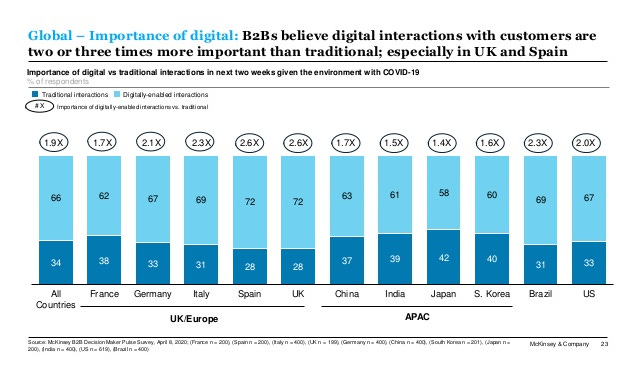B2B decision makers and COVID-19
McKinsey finds out how COVID-19 is changing Global and Indian B2B buyers and sellers interact.

Global sales leaders are calibrating their responses and navigating their organisations with a three-phase action plan to fight against COVID-19.
Navigating the current crisis with resolve and resilience
Planning the recovery
And remaining the next normal
These findings are from McKinsey which also lists that there is a great deal of uncertainty, but there are plenty of signals that indicate an acceleration of previous trends—omnichannel selling, inside sales, tech-enabled selling, e-commerce—rather than completely different behaviors.
To better understand how both customers and sellers are reacting, McKinsey launched a survey of B2B businesses across 11 countries in seven sectors and across 14 categories of spend. These findings reveal three emergent themes:
Spend - While companies are generally reducing spend, a sizable number are increasing or maintaining it, with rates depending on company size, sector, and—more than any other factor—location in the world.
Digital - Looking forward, B2B companies see digital interactions as two to three times more important to their customers than traditional sales interactions.
Remote - Almost 90% of sales have moved to a video conferencing(VC)/phone/web sales model, and while some skepticism remains, more than half believe this is equally or more effective than sales models used before COVID-19.
Let’s take a look at the major findings of the Global B2B report:
Projects on hold - IT is facing the heat
According to the findings of 50% of B2Bs have put half or more of their existing projects on hold. IT sector is facing the biggest hit in countries like India and France. UK and US are the two companies that have also put projects on hold. On the other hand countries like Japan and China have the maximum percentage of projects either not on hold or a few projects on hold.

Transition to the virtual sales model
Lockdowns, shelter-in-place orders, and quarantining have forced people to stay at home have forced almost every business to pivot the way do business. Remote selling has emerged due to the present conditions and the impact of COVID-19.
B2B sellers have reacted with astonishing speed: around 90% of them are working via videoconferencing or phone. China and India lead the way in the scale of this shift, with Spain and the UK not far behind. Not surprisingly, the trend is more pronounced in some sectors than in others: in technology, media, and telecoms, it is almost 100%.

The effectiveness of the virtual sales model has already shown signs of success with the highest effectiveness in India. Sales which was once looked like more of an offline act or a face to face engagement today has transformed into working via VC/Phone. India leads this transformation in the APAC region.

With extended lockdowns and growing cases of COVID-19 Indian companies have adopted the new norm of working from home. Almost 95% of companies have transitioned to at least a partially remote sales model in response to COVID-19. Businesses in the Consumer and Retail, Travel and Transport, and Technology, Media, and Telecom are leading the way when it comes to working remotely or with a virtual sales model.

Transition to digital sales
Digital is the bridge during the challenging times of COVID-19. B2B companies are no exception and believe that digital interactions with customers are two or three times more important than traditional; especially in countries like the UK and Spain.

India ranks slightly lower in APAC when it comes to the digital belief compared to traditional channels but the gap isn’t wide enough.
In fact, India B2B companies have shown a massive transition in the COVID-19 world. Digital enabled sales interactions have massively taken over traditional sales methods and the shift has been at a similar pace in comparison with APAC.

This shift has been possible with sales staff trusting digitally-enabled self serve tools like Web search, Supplier Website, Social Media, etc and Directed tools such as Live Chat, Emails, and Texts.
Sales leaders are already moving aggressively to adjust to the COVID-19 crisis. In addition to adjusting sales forces to remote working, about 70% of companies have also established multi-disciplinary commercial nerve centers to manage sales operations during this time.
In an environment where habits and practices have changed so quickly and will likely continue to do so, sales leaders need a clear view of what their customers want and what steps their company can take to address their needs. Obviously, COVID-19 has shifted the way how sales were operating in the pre-COVID-19 world. With the use of digital channels taking the center stage, B2B companies will have to adopt technologies at a faster rate and also connect with customers in mediums that they are accessible and available.
For now, the debate on the effectiveness of digital sales is mixed. For every respondent who cited it as “less effective,” there was another who thought it was equally or more effective. The report did find some differences by country, however, with India and the US rating remote working highest in perceived effectiveness, at 68 and 60%, respectively.

These are still early days, but we have slowly accepted life with COVID-19. Digital is the only way forward. How effectively we adapt, and meet customer expectations is going to be a big challenge for B2B players.
Old habits don’t die soon and new ones take time.



